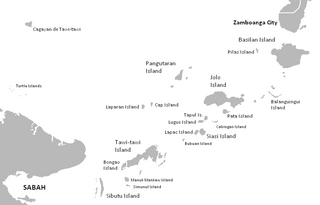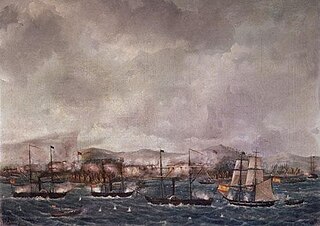
The Sulu Archipelago is a chain of islands in the Pacific Ocean, in the southwestern Philippines. The archipelago forms the northern limit of the Celebes Sea and southern limit of the Sulu Sea. The Sulu Archipelago islands are within the Mindanao island group, consisting of the provinces of Basilan, Sulu, and Tawi-Tawi; hence the archipelago is sometimes referred to as Basulta, derived from the first syllables of the three provinces.

The military history of the Philippines is characterized by wars between Philippine kingdoms and its neighbors in the precolonial era and then a period of struggle against colonial powers such as Spain and the United States, occupation by the Empire of Japan during World War II and participation in Asian conflicts post-World War II such as the Korean War and the Vietnam War. The Philippines has also battled a communist insurgency and a secessionist movement by Muslims in the southern portion of the country.

Isabela, officially the City of Isabela, is a 4th class component city (separate) and de facto capital of the province of Basilan, Philippines. According to the 2020 census, it has a population of 130,379 people.

The Sultanate of Sulu was a Sunni Muslim state that ruled the Sulu Archipelago, coastal areas of Zamboanga City and certain portions of Palawan in the today's Philippines, alongside parts of present-day Sabah and North Kalimantan in north-eastern Borneo.

The Tausūg, are an ethnic group of the Philippines and Malaysia. A small population can also be found in the northern part of North Kalimantan, Indonesia. The Tausūg are part of the wider political identity of Muslim Filipinos of western Mindanao, the Sulu archipelago, and southern Palawan, collectively referred to as the Moro people. The Tausugs originally had an independent state known as the Sultanate of Sulu, which once exercised sovereignty over the present day provinces of Basilan, Palawan, Sulu, Tawi-Tawi, Zamboanga City, eastern part of Sabah and eastern part of North Kalimantan. They are also known in the Malay language as Suluk.

Jolo is a volcanic island in the southwest Philippines and the primary island of the province of Sulu, on which the capital of the same name is situated. It is located in the Sulu Archipelago, between Borneo and Mindanao, and has a population of approximately 500,000 people.

Jolo, officially the Municipality of Jolo, is a 1st class municipality and capital of the province of Sulu, Philippines. According to the 2020 census, it has a population of 137,266 people.

Butig, officially the Municipality of Butig, is a 6th class municipality in the province of Lanao del Sur, Philippines. According to the 2020 census, it has a population of 22,768 people.

Francisco de Tello de Guzmán was Spanish governor of the Philippines from July 14, 1596 to May 1602. He was a knight of the Order of Santiago.

Pedro Bravo de Acuña was a Spanish military officer and colonial official in the New World and the Philippines. From 1602 to 1606 he was the eleventh governor of the Philippines.

Basilan is an island province of the Philippines. It is the largest and northernmost of the major islands of the Sulu Archipelago and is located just off the southern coast of Zamboanga Peninsula. Its capital is Lamitan. Basilan is home to three main ethnic groups, the indigenous Yakans, and the later-arriving Tausugs and Zamboangueños. The Yakans and Tausugs are predomimantly Muslim, while the Chavacanos are mainly Christian. There are also a number of smaller groups.
Sultan Muwallil Wasit, is the 9th Sultan of Sulu and was also known as Rajah Bongsu I. His birth name was Pangiran Shahbandar Maharajalela, and was the youngest son of former Sultan of Brunei Muhammad Hassan. He reigned in Sulu after his uncle, Sultan Batara Shah Tengah died without an heir. He was most likely sent to Sulu to end dynastic troubles there, as he was begot of the marriage of Batara Tengah's Sister, and the Sultan of Brunei. On his coming to Sulu in 1609, he was brought by his father Sultan Muhammad Hassan brought along with his royal symbol's called as "Pulau Janggi" and "Sepong Janggi". This royal symbol was a symbol of brotherhood between the Sultanate of Sulu and the Sultanate of Brunei and as a royal proof that Raja Bongsu-I really belonged to the royal family of Brunei.

The Balanguingui Expedition of 1848 was an amphibious campaign organized by Governor General Narciso Clavería y Zaldúa to capture Balanguingui Island in the Sulu Archipelago from the Moro Pirates, who were using it as a base for their piratical activities.

The Spanish–Moro conflict was a series of battles in the Philippines lasting several centuries. It began during the Spanish Philippines and lasted until the Spanish–American War, when Spain finally began to subjugate the Moro people after centuries of attempts to do so. Spain ultimately conquered portions of the Mindanao and Jolo islands and turned the Sultanate of Sulu into a protectorate, establishing geographic dominance over the region until the Spanish-American War. Moro resistance continued.
The Spanish occupation of Jolo or Battle of Jolo was a military expedition in the 1630s to pacify the Moro of the Sulu Sultanate. The expedition, personally led by Sebastian de Corcuera, the then Governor-General of the Spanish East Indies was a follow-up expedition to the earlier successful campaigns against the Maguindanao Sultanate under Sultan Qudarat. It was initially successful, partly due to an epidemic within the Sultan Wasit's fort early in the campaign, resulting in the Sulu forces retreating to Tawi-Tawi.
Sultan Batara Shah Tengah was the 8th Sultan of Sulu. He reigned from 1596 to 1608. He was the son of the previous Sultan Muhammad ul-Halim, also known as Pangiran Buddiman.
In 1596, the Spanish army launched an expedition to the island of Mindanao to conquer and pacify it; however, the expedition ended in failure and they were forced to withdraw.
The Sulu Expedition of 1602 was an unsuccessful military campaign by the Spanish Empire to capture the island of Jolo. Launched from the Spanish Philippines to suppress Sulu pirates, the expedition ended in failure.
The Sulu Expedition of 1630 was an unsuccessful military campaign by the Spanish Empire to capture the island of Jolo. Launched from the Spanish Philippines to suppress Sulu pirates, the expedition ended in failure.

The Sino-Spanish conflicts were a series of conflicts between the Spanish authorities of the Spanish Empire and its Sangley Chinese residents in Spanish Philippines between the 16th and 18th centuries, which led to massacres of the local Sangley Chinese residents due to generalized Anti-Chinese paranoia by the then ruling Spanish governor-generals.












